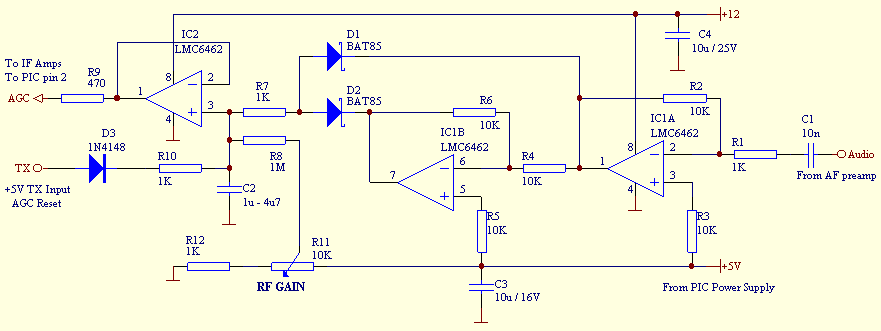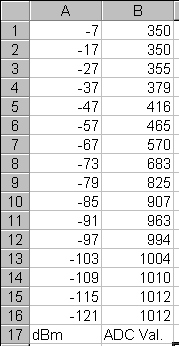Automatic Gain Controll

In an SSB receiver the AGC circuit is extremly important,
Because the signal level is converted into audio level, via the BFO mixer.
The AGC circuit sense the Audio level and control the IF gain
so that the audio level is constant, no matter if the station is local or
DX.
The RF input signal level can change from -120 to +20dBm in a matter of milliseconds,
that is many million times,
This kind of AGC is called Audio AGC and is easy cheap and simple to
construct, the trade off is the attack times will vary depending of Audio
frequency
After constructing this AGC I have tested it both on SSB and CW signals, on
different signal levels, and found it satisfying.
R7 is the ATTACK time, R8 is the RELEASE time
also called HANG time, C2 can be changed to your need of regulation speed,
I have 1uF and 2u2 in parallel.
For SSB only C2 can be 1uF, for CW only C2 can be 10uF, or you can add a switch
to change the attack and release times.
R11 is the RF GAIN or better called IF MAX GAIN, Here the MAXIMUM possible
IF gain can be set like eny other HF Transceiver.
The two op-amps is FET input, Rail to Rail
on both input and output, I think TL072 or even LM358 could be used.
The 470 Ohm resistor in series with the output is to avoid self-oscillation
in the Rail to rail output, This problem apply not to all op-amp types.
The output voltage goes to the two IF amps
and the PIC controller pin 2, The PIC has 10 bits resolution on the ADC, (Analog
to Digital Converter)
This is used for the S-Meter, The S-Meter readout is calibrated using a signal
generator, to show the real S number that represent the signal level
This is the table used to calibrate the read out:
|
dBm
|
S-units
(S9=100 uV, R=50 Ohm) |
|---|---|
|
- 7 dBm
|
S9+60
|
|
- 17
dBm
|
S9+50
|
|
- 27
dBm
|
S9+40
|
|
- 37
dBm
|
S9+30
|
|
- 47
dBm
|
S9+20
|
|
- 57
dBm
|
S9+10
|
|
-67 dBm
|
S9
|
|
-73 dBm
|
S8
|
|
- 79
dBm
|
S7
|
|
- 85
dBm
|
S6
|
|
- 91
dBm
|
S5
|
|
- 97
dBm
|
S4
|
|
- 103
dBm
|
S3
|
|
- 109
dBm
|
S2
|
|
- 115
dBm
|
S1
|
|
- 121
dBm
|
S0
|
Try to measure your own HF rig with a signal generator, then you will see that the S-Meter is unuseable for eny report at all.
Here is a few YAESU rigs that I have tested and measured their S-Meter read out..
|
FT-817
Measured
|
FT-757
Measured
|
S-units
(dBm) Correct value
|
|---|---|---|
|
-41 dBm
|
-23 dBm
|
S9+60
(-7 dBm)
|
|
-47 dBm
|
-39 dBm
|
S9+40
(-27 dBm)
|
|
-77 dBm
|
-57 dBm
|
S9+20
(-47 dBm)
|
|
-80 dBm
|
-73 dBm
|
S9 (-67
dBm 100uV)
|
|
-95 dBm
|
-79 dBm
|
S8 (-73
dBm)
|
|
-98 dBm
|
-83 dBm
|
S7 (-79
dBm)
|
|
-99 dBm
|
-87 dBm
|
S6 (-85
dBm)
|
|
-100
dBm
|
-89 dBm
|
S5 (-91
dBm)
|
|
-101
dBm
|
-95 dBm
|
S4 (-97
dBm)
|
|
-101
dBm
|
-97 dBm
|
S3 (-103
dBm)
|
|
-102
dBm
|
-100
dBm
|
S2 (-109
dBm)
|
|
-103
dBm
|
-102
dBm
|
S1 (-115
dBm)
|
|
-104
dBm
|
-104
dBm
|
S0 (-121
dBm)
|

Here is the AGC voltage seen from the PIC ADC,
The ADC is 10 bits, so 0V is 0000 and 5V is 1023

The table can also be viewed as a curve,
If I just had mounted a normal meter, the S meter readout would be verry un-linear.
That is why I use the PIC and the LCD display to show the signal strength.

|
Ham radio Data Center - free schematics | Free HAM Directory | About me | Acronyms
| CW | Data
Sheets | Docs | Download | E-mail | HOME | Ham projects | Hobby
circuits | Photo galery | PIC | QTH
photos |
Sign
in my guestbook | View
my guestbook ]
© 2001 - YO5OFH, Csaba Gajdos